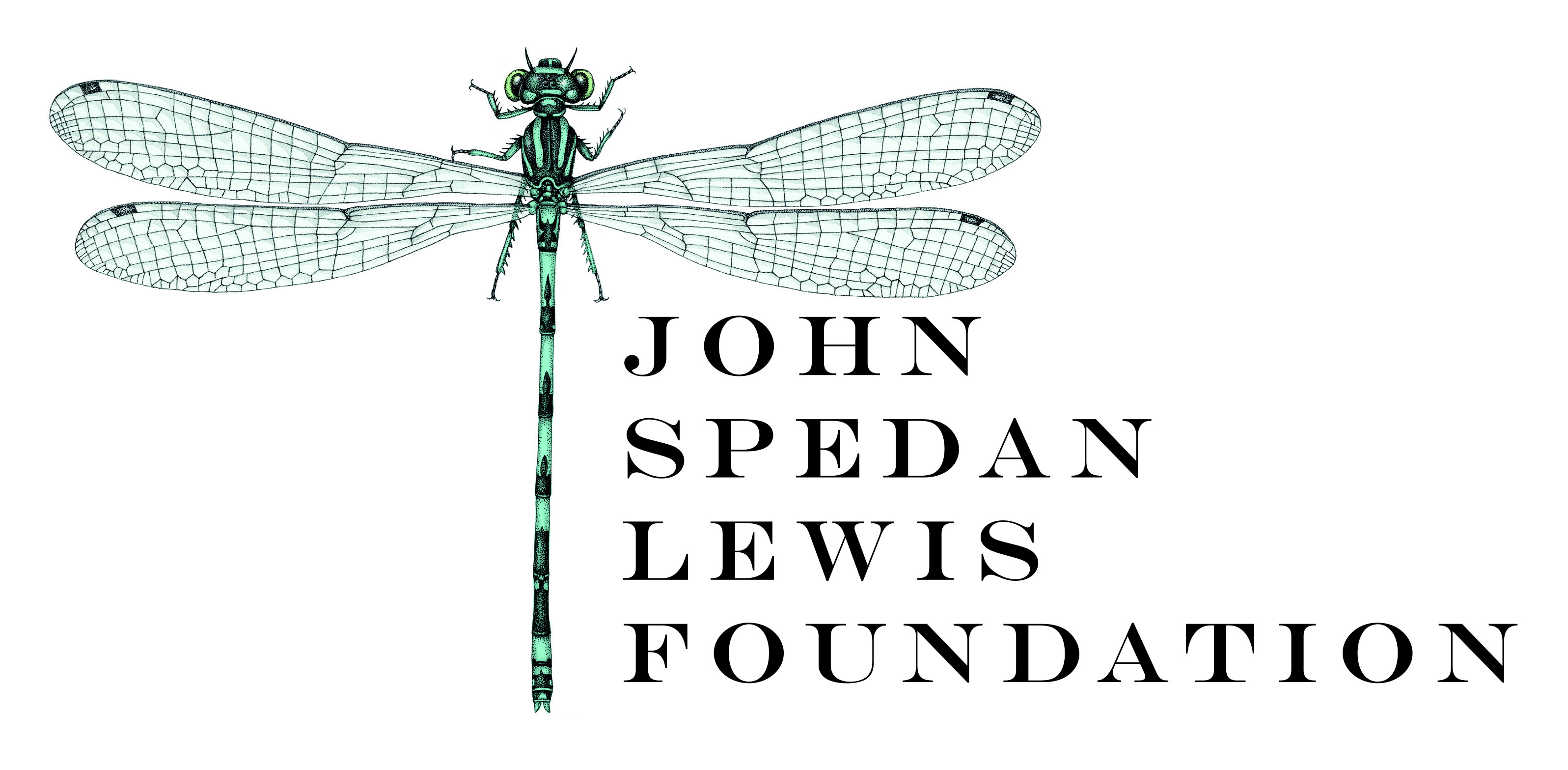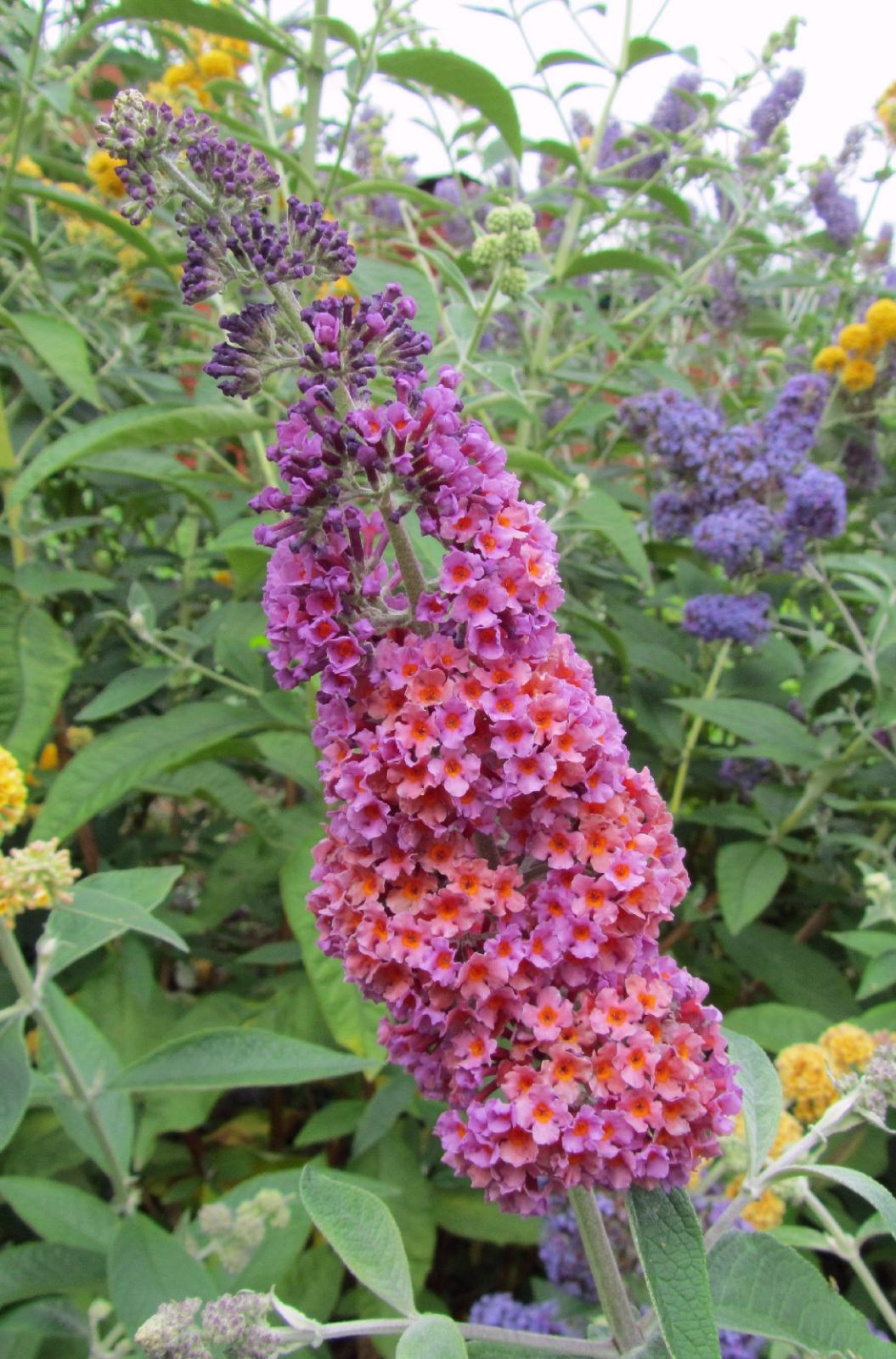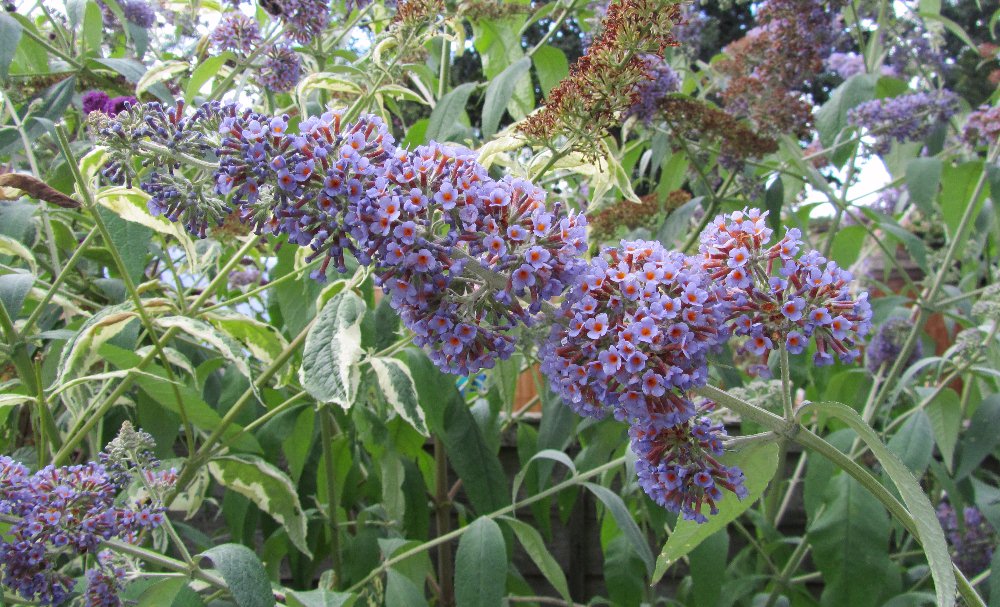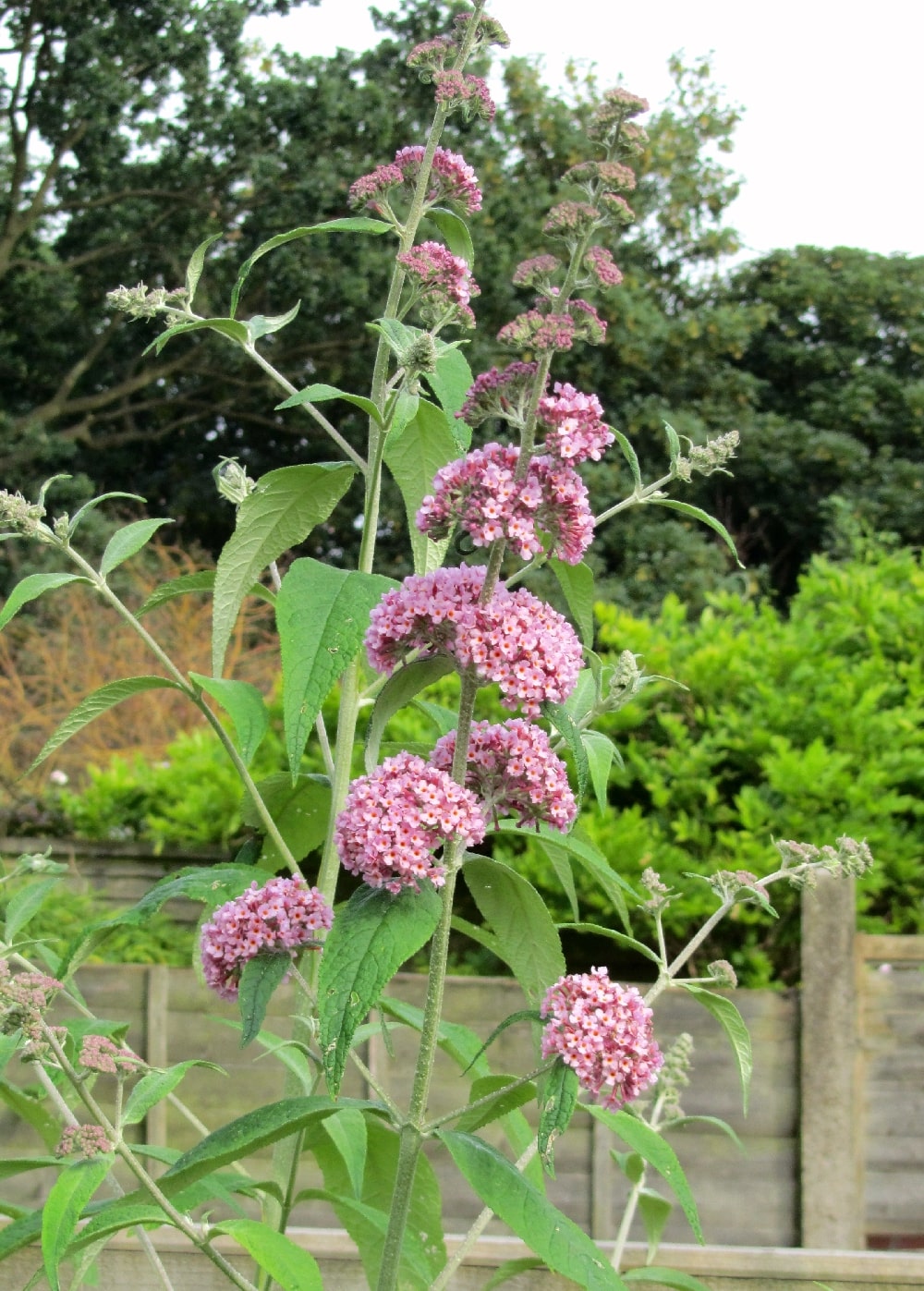Buddleja × weyeriana Hybrids
Sponsor
Kindly sponsored by
The John Spedan Lewis Foundation

Credits
Andrew Large (2021)
Recommended citation
Large, A.T. (2021), 'Buddleja × weyeriana Hybrids' from the website Trees and Shrubs Online (treesandshrubsonline.
Genus
Infraspecifics
Other taxa in genus
- Buddleja albiflora
- Buddleja alternifolia
- Buddleja araucana
- Buddleja asiatica
- Buddleja auriculata
- Buddleja caryopteridifolia
- Buddleja colvilei
- Buddleja cordata
- Buddleja crispa
- Buddleja crispa × lindleyana
- Buddleja curviflora
- Buddleja davidii
- Buddleja delavayi
- Buddleja fallowiana
- Buddleja fallowiana × davidii
- Buddleja FLUTTERBY™ Series
- Buddleja forrestii
- Buddleja globosa
- Buddleja glomerata
- Buddleja japonica
- Buddleja lindleyana
- Buddleja LO AND BEHOLD® Series
- Buddleja longiflora
- Buddleja loricata
- Buddleja × luteolufaucia
- Buddleja macrostachya
- Buddleja marrubiifolia
- Buddleja megalocephala
- Buddleja 'Miss Ruby'
- Buddleja 'Morning Mist'
- Buddleja myriantha
- Buddleja New Dwarf Hybrids
- Buddleja nivea
- Buddleja officinalis
- Buddleja 'Orange Sceptre'
- Buddleja paniculata
- Buddleja × pikei
- Buddleja 'Pink Delight'
- Buddleja saligna
- Buddleja 'Salmon Spheres'
- Buddleja salviifolia
- Buddleja 'Silver Frost'
- Buddleja speciosissima
- Buddleja 'Summer Beauty'
- Buddleja virgata
- Buddleja × wardii
- Buddleja × weyeriana
- Buddleja 'Winter Sun'
Habitat Of garden origin.
USDA Hardiness Zone 6-9
RHS Hardiness Rating H5
This article covers seedlings of the hybrid B. × weyeriana back-crossed with various B. davidii cultivars. In all respects their form and habit resembles B. davidii, with very little contribution from B. globosa apparent in their appearance. Back-crosses such as those covered in this article do technically retain the nothospecific epithet, so the cultivars treated here could be written directly as B. × weyeriana cultivars, but given they bear little resemblance to the original hybrid we have chosen to treat them separately.
These hybrids have the advantage of a zero or very low seed set, so are generally considered non-invasive. Conversely, some cultivars are known to produce viable pollen (C. Valin, pers. comm.). Several have become popular garden cultivars and are widely available. Generally they are large, well-branched shrubs with mid- to dark-green leaves, grey-tomentose on the undersides; they are semi-evergreen, only losing all their leaves in particularly harsh winter conditions. The inflorescences are often large and showy; although not conspicuously different in form to B. davidii, the flower panicle may display some tendency towards being more stepped, or in loose balls (significantly looser than in B. globosa). There is a residual yellow-gold pigment in the corolla of at least one cultivar, which becomes apparent only as the flowers fade. Flowering starts a week or two later than B. davidii in the summer (late July in northern Europe).
These hybrids can grow into large plants, to the proportions of a small tree, but can be pruned in spring in much the same way as B. davidii. The growing conditions are the same as B. davidii – a sunny position in well-drained, rich soil, particularly the soil should not be prone to winter waterlogging. They can be marginally less hardy than the most robust of the B. davidii cultivars, but usually will survive a down to –15ºC (pers. obs.).
Two members of the FLUTTERBY™ Series Buddlejas fall within the parameters of this article as they have B. × weyeriana ‘Honeycomb’ in their ancestry: ‘Podara #01’ (FLUTTERBY GRANDE™ VANILLA) and ‘Podaras #05’ (FLUTTERBY GRANDE™ PEACH COBBLER). These are each discussed under Buddleja FLUTTERBY™ Series.
'Attraction'
Synonyms / alternative names
Buddleja × weyeriana 'Attraction'
Buddleja 'Attraction'
Buddleja ‘Attraction’ is a deep pink-purple hybrid from an open pollination of ‘Honeycomb’, selected by Mike Dirr at the Univeristy of Georgia in the early 2000s. This cultivar is probably most notable for being a parent of the almost red-coloured hybrids ‘Miss Ruby’ and LO AND BEHOLD® ‘Miss Molly’ (‘Red Chip’) (Werner & Snelling 2009). ‘Attraction’ is not common in Europe.
'Bicolor'
Synonyms / alternative names
Buddleja × weyeriana 'Flower Power'
Buddleja 'Flower Power'
Buddleja 'Bicolor'
Buddleja ‘Bicolor’ (known as ‘Flower Power’ in the UK) is an American hybrid raised by Michael Dirr in Athens, Georgia, in 1999. It arose from a cross of B. × weyeriana ‘Honeycomb’ with an unknown cultivar of B. davidii. It makes a large shrub with dark greyish-green leaves. The inflorescences are dense panicles, which at up to 25 cm are quite short by modern standards. The flowers are a bright-mauve purple, fading to an orangey-brown colour best described as butterscotch (Stuart 2006). The bi-coloured effect is the unique selling point for this hybrid and it has become popular in both the USA and Europe, however, as a cultivar name in latin form published after 1959, the name ‘Bicolor’ is invalid.
'Boy Blue'
Synonyms / alternative names
Buddleja × weyeriana 'Blue Boy'
Buddleja 'Blue Boy'
Buddleja × weyeriana 'Boy Blue'
Buddleja 'Boy Blue'
A very large and vigorous cultivar with large mid-green leaves, bred c. 2000 by Peter Moore of the Longstock Nursery, UK. The parent plants are not recorded, other than the seed parent being one of the B. × weyeriana cultivars. The inflorescences are large and the flowers lavender blue with a distinct orange-red centre (Moore 2016).
'Pink Pagoda'
Synonyms / alternative names
Buddleja INSPIRED® PINK
Buddleja × weyeriana INSPIRED® PINK
Buddleja × weyeriana 'Pink Pagoda'
Buddleja 'Pink Pagoda'
This hybrid is a cross of B. × weyeriana ‘Sungold’ pollinated by B. ‘Pink Delight’ and was raised by Peter Moore of the Longstock Nursery, Hampshire, UK in 1994. ‘Pink Pagoda’ is a medium to large shrub (2–3 m height) with mid-green foliage and an upright habit. It bears large inflorescences up to 40 cm long made up of very loose balls in levels rising up the panicle. The flowers are a delicate pink, each with a yellow-gold eye. The name was reportedly coined by the renowned plantsman Roy Lancaster, reflecting the stepped appearance of the flower panicle (Moore 2016). It is completely seed-sterile (pers. obs.).
‘Pink Pagoda’ was added to the INSPIRED® range of Buddleia for the USA market, where it is known as INSPIRED® PINK.




